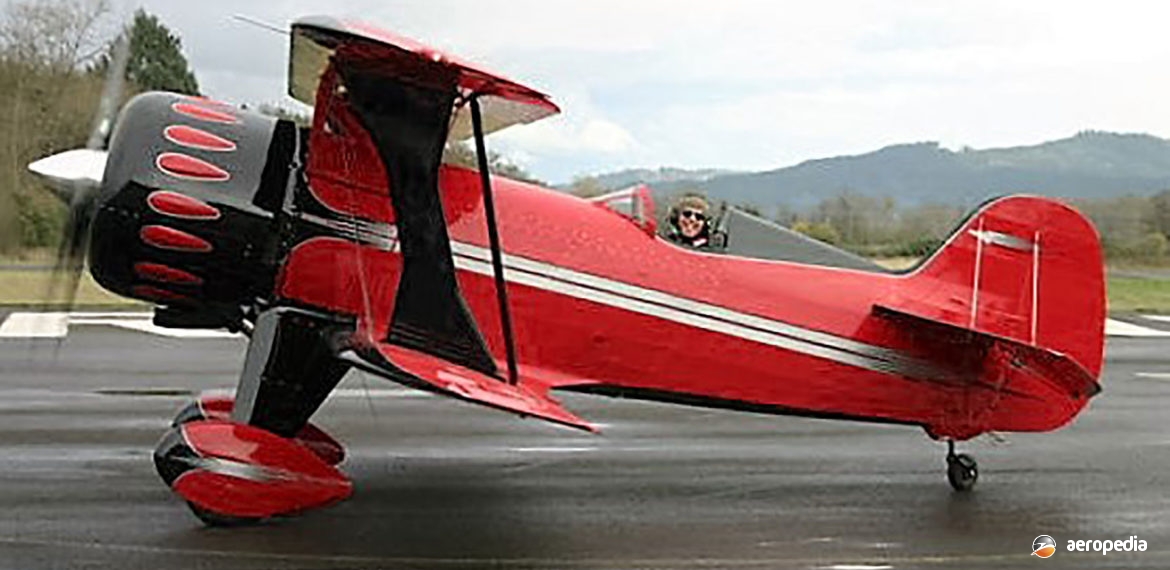Photograph:
An American registered Samson (Author’s collection)
Country of origin:
United States of America
Description:
Single-seat high performance aerobatic biplane
Power Plant:
One 336 kw (450 hp) Pratt & Whitney R-985 Wasp Junior nine-cylinder air-cooled radial engine
Specifications:
- Wing area: 17.18 m² (185 sq ft)
- Aspect ratio: 5.76
- Wing loading [gross weight]: 14.14 lb/sq ft
- Power loading [gross weight]: 5.86 lb/hp
- Cruising speed: 290 km/h (180 mph)
- Empty weight: 862 kg (1,900 lb)
- Loaded weight: 1,212 kg (2,671 lb)
- Aerobatic weight: 1,046 kg (2,307 lb)
History:
For many years Curtis Pitts designed high-performance aerobatic monoplanes, his first being built in 1941 and known as the Pitts Special, being fitted with a 34 kw (45 hp) engine. Development was interrupted by World War II but thereafter his second design was built, had a 63 kw (85 hp) engine, and was sold to Betty Skelton, who won the Women’s International Championship in 1949 and 1950. Over the years the Pitts has been renowned for its aerobatic capabilities and continues to be built and flown in a variety of models with a range of engines around the world.
In 1948 Pitts built a larger variant of the Special using war service parts which were freely available at the time, and which would achieve the maximum power to weight ratio available. Known as the Samson, it was built for a pilot who made a living flying the airshow circuit in the United States. Fitted with a 336 kw (450 hp) Pratt & Whitney R-985 Wasp Junior radial engine it was said it could out-climb every fighter aircraft produced during World War II, but the aircraft was eventually destroyed in a fire in 1952.
In 1985 Wolf Aircraft in the US built a replica of the Samson, again fitted with an R-985 engine, with a 3.04 m (10 ft) diameter propeller. The tips of the propeller became supersonic during display flying, which added to its noise. It had dual smoke pumps. It came to be known for delivering spectacular noisy airshow routines. Since then Wolf Aircraft has built a further example for a German pilot, and is known for building one-off replicas, having also built a replica of the Howard Hughes racing monoplane.
Well known Australian aerobatic identity, Pip Borrman of Shepparton, VIC, who flewAviation airshow routines for some years in a Zivco Edge, had a Samson built by B & R Aviation of Toowoomba, QLD. Planning for the new type was commenced by Barry Manktelow at B & R Aviation but he was later joined in the project by Mr Borrman. Construction commenced in 2000 and the builders constructed what is considered to be a replica of the original but with up-dating of the original design to meet modern standards with modern equipment. Engine was the R-985 Wasp Junior radial with fuel injection driving a German-built three-blade MT propeller.
The fuselage was completed in early 2006, the aircraft eventually being shipped to Shepparton, VIC for covering and final fit out. The wing of this machine was unique in that it used a Beech 17 aerofoil section, this being known for its exceptional performance. The aircraft was basically all-metal but carbon fibre panels were used in the airframe, and the ailerons on both wings were copied from those used on the Pitts Super Stinker. Climb rate in excess of 1,676 m/min (5,500 ft/min) was expected to be achieved, and a fast roll rate was available. This aircraft was completed in mid 2008 and registered VH-EAB (c/n 001) on 21 December 2006.
However, tragically, on 25 February 2009 Pip Borrman whilst flying the Pitts Samson near Shepparton, VIC, whilst performing aerobatics practising for the Australian International Airshow at Avalon, lost control when the aircraft suffered an engine failure, the aircraft crashing into a paddock near the airport. Mr Borrman lost his life and the aircraft was destroyed.
Another variant of the Pitts series is the Model 12 designed in 1996 and this has been referred to as a modern variant of the Samson and is fitted with the Russian-designed Vedeneyev M14P radial engine providing up to 298 kw (400 hp). More than 200 examples of this model have been sold and a variant of this is produced in kit form by Kimball Enterprises.

